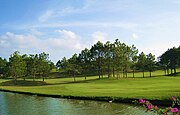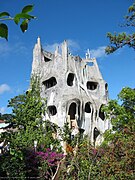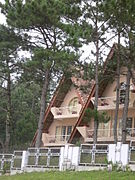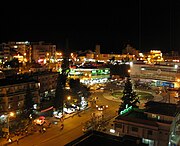Da Lat: Difference between revisions
mNo edit summary |
Cyberbot II (talk | contribs) Rescuing 2 sources, flagging 0 as dead, and archiving 3 sources. #IABot |
||
| Line 296: | Line 296: | ||
[[File:HangNgaCrazyHouse1.jpg|thumb|left|200px|[[Hang Nga guesthouse|Hằng Nga guesthouse]] is decorated with twisting organic forms.]] |
[[File:HangNgaCrazyHouse1.jpg|thumb|left|200px|[[Hang Nga guesthouse|Hằng Nga guesthouse]] is decorated with twisting organic forms.]] |
||
Of particular note is the unconventional architecture of the [[Hang Nga guesthouse|Hằng Nga guesthouse]], popularly known as the “Crazy House”. Described as a “fairy tale house”, its overall design resembles a giant [[banyan]] tree, incorporating sculptured design elements representing natural forms such as animals, mushrooms, spider webs and caves. Its architecture, consisting of complex, organic, non-rectilinear shapes, has been described as [[Expressionist architecture|expressionist]]. Its creator, Vietnamese architect Dang Viet Nga (also known as Hằng Nga), who holds a PhD in architecture from [[Moscow State University]], has acknowledged the inspiration of [[Catalan people|Catalan]] [[Spanish people|Spanish]] architect [[Antoni Gaudí]] in the building’s design. Visitors have variously drawn parallels between the guesthouse and the works of artists such as [[Salvador Dalí]] and [[Walt Disney]].<ref name="untrvdest">{{cite web|title=The Crazy House|url=http://www.unusual-travel-destinations.com/Crazy_House.html|work=Unusual Travel Destinations|publisher=Unusual-Travel-Destinations.com|accessdate=24 September 2012|author=Fida Wild|year=2009–2012}}</ref><ref name="globe">[http://www.theglobeandmail.com/life/article639415.ece Madame Hang Nga's Crazy House]. Maggie Huff-Rousselle. The ''Globe and Mail''.{{ |
Of particular note is the unconventional architecture of the [[Hang Nga guesthouse|Hằng Nga guesthouse]], popularly known as the “Crazy House”. Described as a “fairy tale house”, its overall design resembles a giant [[banyan]] tree, incorporating sculptured design elements representing natural forms such as animals, mushrooms, spider webs and caves. Its architecture, consisting of complex, organic, non-rectilinear shapes, has been described as [[Expressionist architecture|expressionist]]. Its creator, Vietnamese architect Dang Viet Nga (also known as Hằng Nga), who holds a PhD in architecture from [[Moscow State University]], has acknowledged the inspiration of [[Catalan people|Catalan]] [[Spanish people|Spanish]] architect [[Antoni Gaudí]] in the building’s design. Visitors have variously drawn parallels between the guesthouse and the works of artists such as [[Salvador Dalí]] and [[Walt Disney]].<ref name="untrvdest">{{cite web|title=The Crazy House|url=http://www.unusual-travel-destinations.com/Crazy_House.html|work=Unusual Travel Destinations|publisher=Unusual-Travel-Destinations.com|accessdate=24 September 2012|author=Fida Wild|year=2009–2012}}</ref><ref name="globe">[http://www.theglobeandmail.com/life/article639415.ece Madame Hang Nga's Crazy House]. Maggie Huff-Rousselle. The ''Globe and Mail''. {{wayback|url=http://www.theglobeandmail.com/life/article639415.ece |date=20110707031743 }}</ref> Since its opening in 1990, the building has gained recognition for its unique architecture, having been highlighted in numerous guidebooks and listed as one of the world’s ten most “bizarre” buildings in the Chinese [[People's Daily|People’s Daily]].<ref name="nhandan">{{cite news|title=Da Lat ‘Crazy House’ joins bizarre global list|url=http://en.vietnamplus.vn/Home/Da-Lat-Crazy-House-joins-bizarre-global-list/20099/2693.vnplus|accessdate=24 September 2012|newspaper=Vietnam Plus|date=22 September 2009|agency=Vietnam News Agency (VNA)}}</ref><ref name="vnnet-06">[http://english.vietnamnet.vn/travel/2006/07/596670/ Da Lat's "Crazy House"] {{wayback|url=http://english.vietnamnet.vn/travel/2006/07/596670/ |date=20080612131041 }}</ref> While superficially amusing, the compound is let down by the construction debris and household refuse behind the facades, and the lack of attention to safety issues. |
||
==Gallery== |
==Gallery== |
||
Revision as of 14:11, 11 January 2016
This article needs additional citations for verification. (May 2010) |
Đà Lạt
Thành phố Đà Lạt | |
|---|---|
| transcription(s) | |
| • Quốc ngữ | Thành phố Đà Lạ |
| • Chữ Nôm | 城舖沱辣 |
 Da Lat Market (left) on Hoa Binh Square | |
| Nickname: City of flowers | |
| Country | |
| Province | Lâm Đồng |
| Region | Central Highlands |
| Demonym | Dalatese |
| Area | |
| • Total | 394.38 km2 (152.27 sq mi) |
| Elevation | 1,500 m (4,900 ft) |
| Population (2010) | |
| • Total | 209,301 |
Đà Lạt (Vietnamese pronunciation: [ɗâː làːt] ), or Dalat (pop. 206,105 as of 2009[update], of which 185,509 are urban inhabitants), is the capital of Lâm Đồng Province in Vietnam. The city is located 1,500 m (4,900 ft) above sea level on the Langbian Plateau in the southern parts of the Central Highlands region. In Vietnam, Da Lat is a popular tourist destination.
Da Lat's specific sights are pine wood (forming the name: "City of thousands of pine trees") with twisting roads and tree marigold (Vietnamese: dã quỳ) blossom in the winter. The city’s temperate weather stands in contrast to Vietnam's otherwise tropical climate. Mist covering the valleys almost year-round leads to its name "City of Eternal Spring".
Da Lat is also known as an area for scientific research in the fields of biotechnology and nuclear physics.
With its year-round cool weather, Da Lat supplies temperate agriculture products for all over Vietnam, for example: cabbage and cauliflower. Its flower industry produces two typical flowers: hydrangea (Vietnamese: cẩm tú cầu) and golden everlasting (Vietnamese: hoa bất tử). The confectionery industry offers a wide range of mứt, a kind of fruit preserve made from strawberry, mulberry, sweet potato, and rose.
Name
According to some sources, the name derives from the acronym of the Latin phrase 'Dat Aliis Laetitiam Aliis Temperiem' ("It Gives Pleasure to Some, Freshness to Others"), which the French colonial government used in their official emblem of Đà Lạt. In reality, the name Da Lat derived from the language of the local ethnic group Lạt and its original meaning is "Stream of the Lạt", and the acronym above is in fact a backcronym.
History

During the 1890s, explorers in the area (including the noted bacteriologist Alexandre Yersin, protégé of the renowned French chemist Louis Pasteur), which was then part of the French territory of Cochinchina, asked the French governor-general, Paul Doumer, to create a resort center in the highlands. The governor agreed. The original intended site for the hill station was Dankia, but Étienne Tardif, a member of the road-building expedition of 1898-99, proposed the current site instead. In 1907, the first hotel was built. Urban planning was carried out by Ernest Hébrard.[1]

The French endowed the city with villas and boulevards, and its Swiss charms remain today. Hébrard included the requisite health complex, golf course, parks, schools, and homes but no industry. The legacy of boarding schools where children from the whole of Indochina were taught by French priests, nuns, and expatriates still existed as late as 1969. In 1929, the Christian and Missionary Alliance established a school (Dalat International School) for Canadian and American children of missionaries serving in Southeast Asia. In 1965, the school moved to Bangkok, Thailand; then in 1966 to the Cameron Highlands in Malaysia and then, in June 1971, moved to its present location in Georgetown, Malaysia. There were seminaries of Jesuits (such as Pius X Pontifical College) and other orders. The elite Vietnamese National Military Academy graduated its first class of future leaders in 1950. There was an aviation school at Cam Ly Airport.
During World War II, Đà Lạt was the capital of the Federation of Indochina, from 1939 to 1945.
In the mid-1950s, the Vietnamese Scout Association established their national training grounds at Đà Lạt.
The only major involvement Da Lat had during the Vietnam War was within the 1968 Tet Offensive. Fierce battles raged from January 31 to February 9, 1968. Most of the fighting took place between the South Vietnamese MP units stationed in Đà Lạt and the Việt Cộng (VC) forces. American MPs were also involved in the fighting and suffered several KIAs during a rocket attack on their compound. Defeats and victories alternated between the two during the sporadic-yet-intense battles. However, the South Vietnamese MPs were eventually able to regain control of Đà Lạt. It is stated that around 200 VC were killed-in-action (KIAs) during this battle. Although South Vietnamese MP forces were known to have significantly fewer KIAs, their injured list grew steadily throughout the engagement because of periods of low supplies and support. What ultimately saved the South Vietnamese MPs was the fact that they held strong defensive positions throughout Đà Lạt from the beginning to the end of the battles.
Geography

Đà Lạt is located 1,500 m (4,900 ft) above sea level on the Langbian Plateau in the southern parts of the Central Highlands (in Vietnamese, Tây Nguyên). The constructed Xuan Huong Lake—measuring 5 square kilometres (1.9 sq mi)—is located in central Đà Lạt and, following repair work, the lake is completely filled as of October 2011.
Geology
Đà Lạt is a source area for pyroxene from the Australasian strewnfield.[2]
Administrative
Đà Lạt is divided into 12 wards which are numbered 1 to 12, and 4 communes: Ta Nung, Xuan Truong, Xuan Tho and Trại Hầm.[3]
Climate
Da Lat's year-round temperate weather, standing in contrast to central & southern Vietnam’s otherwise-tropical climate, has led it to be nicknamed the “City of eternal spring”.[4] The average temperature is 14 °C (57 °F) - 23 °C (73 °F). The highest temperature ever in Da Lat was 31.5 °C (88.7 °F), and the lowest was −0.6 °C (30.9 °F).[5] Mist covers the adjoining valleys almost year-round. Its temperate climate also makes it ideal for agriculture. Indeed, Da Lat is renowned for its orchids, roses, vegetables, and fruits. There are nascent wine-making and flower-growing industries in the region.
There are two separate seasons in Da Lat. The rainy season lasts from May to October, and the dry season is from November to April. The average annual precipitation is 1,770mm.[6]
| Climate data for Da Lat (1964–1998) | |||||||||||||
|---|---|---|---|---|---|---|---|---|---|---|---|---|---|
| Month | Jan | Feb | Mar | Apr | May | Jun | Jul | Aug | Sep | Oct | Nov | Dec | Year |
| Record high °C (°F) | 30.0 (86.0) |
31.0 (87.8) |
31.5 (88.7) |
31.2 (88.2) |
30.6 (87.1) |
30.0 (86.0) |
29.2 (84.6) |
29.3 (84.7) |
29.7 (85.5) |
30.0 (86.0) |
29.2 (84.6) |
29.4 (84.9) |
31.5 (88.7) |
| Mean daily maximum °C (°F) | 22.3 (72.1) |
24.0 (75.2) |
25.0 (77.0) |
25.2 (77.4) |
24.5 (76.1) |
23.4 (74.1) |
22.8 (73.0) |
22.5 (72.5) |
22.8 (73.0) |
22.5 (72.5) |
21.7 (71.1) |
21.4 (70.5) |
23.2 (73.8) |
| Daily mean °C (°F) | 15.8 (60.4) |
16.7 (62.1) |
17.8 (64.0) |
18.9 (66.0) |
19.3 (66.7) |
19.0 (66.2) |
18.6 (65.5) |
18.5 (65.3) |
18.4 (65.1) |
18.1 (64.6) |
17.3 (63.1) |
16.2 (61.2) |
17.9 (64.2) |
| Mean daily minimum °C (°F) | 11.3 (52.3) |
11.7 (53.1) |
12.6 (54.7) |
14.4 (57.9) |
16.0 (60.8) |
16.3 (61.3) |
16.0 (60.8) |
16.1 (61.0) |
15.8 (60.4) |
15.1 (59.2) |
14.3 (57.7) |
12.8 (55.0) |
14.3 (57.7) |
| Record low °C (°F) | −0.1 (31.8) |
−0.6 (30.9) |
4.2 (39.6) |
4.0 (39.2) |
10.0 (50.0) |
10.9 (51.6) |
10.4 (50.7) |
10.6 (51.1) |
10.0 (50.0) |
8.1 (46.6) |
4.4 (39.9) |
2.6 (36.7) |
−0.6 (30.9) |
| Average precipitation mm (inches) | 11 (0.4) |
24 (0.9) |
62 (2.4) |
170 (6.7) |
191 (7.5) |
213 (8.4) |
229 (9.0) |
214 (8.4) |
282 (11.1) |
239 (9.4) |
97 (3.8) |
36 (1.4) |
1,739 (68.5) |
| Average rainy days | 2 | 2 | 5 | 11 | 18 | 20 | 23 | 22 | 23 | 19 | 10 | 5 | 161 |
| Average relative humidity (%) | 82 | 78 | 77 | 84 | 87 | 88 | 90 | 91 | 90 | 89 | 85 | 84 | 85 |
| Mean monthly sunshine hours | 214.0 | 220.3 | 206.8 | 196.7 | 176.1 | 158.2 | 128.3 | 130.0 | 102.4 | 144.7 | 168.6 | 190.2 | 2,036.3 |
| Source 1: Địa chí Đà Lạt (extremes 1918–1940, and 1964–1998)[5] | |||||||||||||
| Source 2: General Statistics Office of Vietnam (sun 2002–2013)[7] | |||||||||||||

Architecture
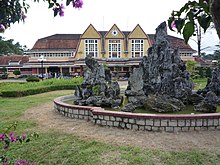
The architecture of Đà Lạt is dominated by the style of the French colonial period. Đà Lạt Railway Station, built in 1938, was designed in the Art Deco architectural style by French architects Moncet and Reveron, although it incorporates the high, pointed roofs characteristic of the Cao Nguyen communal buildings of Vietnam’s Central Highlands. The three gables represent an art deco version of Normandy’s Trouville-Deauville Station.[8] The station’s unique design—with its roofs, arching ceiling, and coloured glass windows—earned it recognition as a national historical monument in 2001.[9][10] They designed the Lycée Yersin, which opened in 1927.[11] The Dominion of Mary Church and Convent, home to Roman Catholic nuns of the Mission of Charity, were built in 1938 with a similar pointed-roof style.
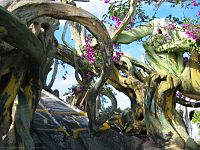
Of particular note is the unconventional architecture of the Hằng Nga guesthouse, popularly known as the “Crazy House”. Described as a “fairy tale house”, its overall design resembles a giant banyan tree, incorporating sculptured design elements representing natural forms such as animals, mushrooms, spider webs and caves. Its architecture, consisting of complex, organic, non-rectilinear shapes, has been described as expressionist. Its creator, Vietnamese architect Dang Viet Nga (also known as Hằng Nga), who holds a PhD in architecture from Moscow State University, has acknowledged the inspiration of Catalan Spanish architect Antoni Gaudí in the building’s design. Visitors have variously drawn parallels between the guesthouse and the works of artists such as Salvador Dalí and Walt Disney.[12][13] Since its opening in 1990, the building has gained recognition for its unique architecture, having been highlighted in numerous guidebooks and listed as one of the world’s ten most “bizarre” buildings in the Chinese People’s Daily.[14][15] While superficially amusing, the compound is let down by the construction debris and household refuse behind the facades, and the lack of attention to safety issues.
Gallery
-
A golf course in Da Lat
-
Golden Valley in the morning mist
-
Decorations during the Dalat Flower Festival
-
A villa in Dalat's pine forest
-
A hydrangea flower in Da Lat
-
Coffee terrace near Da Lat
-
Artichoke tea, a product of Dalat
-
Da Lat's Market square at night
-
Da Lat, "Le Petit Paris"-"Little Paris"
Most popular places
- Truc Lam Monastery
- The Palace of Bao Dai King
- Ho Xuan Huong
- Dreamlike Hill (Mong Mo Hill)
- Langbiang Peak
- Prenn Waterfall
- Valley of Love
- Dalat Cathedral (also known as "Chicken Church")
- Domaine de Marie
- Golden Stream Lake
See also
- Da Lat Railway Station
- Da Lat–Thap Cham Railway
- Hang Nga guesthouse
- Dalat Palace Hotel
- Dalat City
- Dalat International School in Penang, Malaysia, named after the city where it was originally located
References
- ^ Crossette, Barbarạ The Great Hill Stations of Asia. Boulder, CO: Westview Press, 1998. pp 207-219.
- ^ Sciencedirect.com[dead link]
- ^ Vietnam Daily News dailynews.vn[dead link] [dead link]
- ^ Lonely Planet Vietnam, (Lonely Planet, 2007), ISBN 1-74059-677-3, pp. 290–305.
- ^ a b "KHÍ HẬU" (in Vietnamese). City Of Da Lat. Archived from the original on 2 March 2013. Retrieved 26 January 2015.
- ^ "Da Lat". Encyclopædia Britannica. 2012. Retrieved 22 September 2012.
- ^ "Monthly Sunshine duration by Cities, provinces, Month and Year". General Statistics Office of Vietnam. Retrieved August 1, 2015.
- ^ Samantha Coomber (1 January 2008). "Paradise by the Dashboard Light". Air Canada enroute. Air Canada enRoute. Retrieved 22 September 2012.
- ^ Minh Thu (2009-02-22). "Little Paris charms visitors". Asia News Network. Retrieved 2010-07-16.
- ^ John Colet, Joshua Eliot (2002). Vietnam handbook. Footprint Travel Guides. ISBN 1-903471-31-1. Retrieved 2010-07-28.
- ^ "Dalat (Đà Lạt)". Saigon Vietnam (in French). Retrieved 2015-11-07.
- ^ Fida Wild (2009–2012). "The Crazy House". Unusual Travel Destinations. Unusual-Travel-Destinations.com. Retrieved 24 September 2012.
- ^ Madame Hang Nga's Crazy House. Maggie Huff-Rousselle. The Globe and Mail. Archived 2011-07-07 at the Wayback Machine
- ^ "Da Lat 'Crazy House' joins bizarre global list". Vietnam Plus. Vietnam News Agency (VNA). 22 September 2009. Retrieved 24 September 2012.
- ^ Da Lat's "Crazy House" Archived 2008-06-12 at the Wayback Machine
External links
 Da Lat travel guide from Wikivoyage
Da Lat travel guide from Wikivoyage- Official website of the provincial government (Vietnamese)

